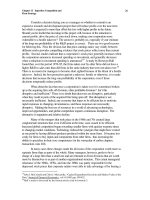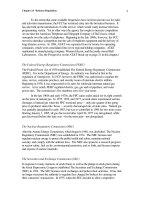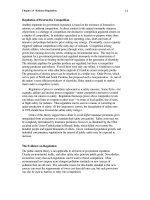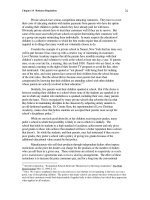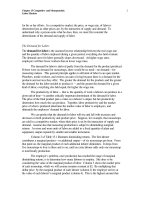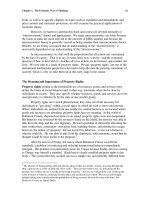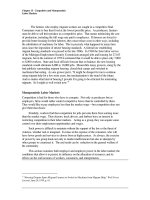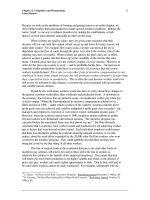Microeconomics for MBAs 49
Bạn đang xem bản rút gọn của tài liệu. Xem và tải ngay bản đầy đủ của tài liệu tại đây (38.54 KB, 10 trang )
Chapter 14 Business Regulation
24
Private schools face serious competition attracting customers. They have to cover
their costs of educating students with tuition payments from parents who have the option
of sending their children to public schools they have already paid for with taxes.
Obviously private schools have to treat their customers well if they are to survive. But
some of the most successful private schools recognize that treating their customers well
as a group can require mistreating them individually. In many respects the education of
children is a collective enterprise in which the best results require that all customers be
required to do things that many would not voluntarily choose to do.
Consider the example of a private school in Nanuet, New York that has done very
well in part because it has come up with a creative way of mistreating its customers.
Love Christian Academy requires that all the parents have monthly meetings with their
children’s teachers and volunteer to work at the school at least one day a year. If parents
miss, or are even late for, a meeting, they are fined $100. Parents who are fined, or who
must attend a meeting on the night of their favorite TV programs to avoid the fine, often
feel mistreated. One parent was quoted as “not pleased” with being fined for violating
one of the rules, and some parents have removed their children from the school because
of the strict rules. But the school thrives because most parents feel more than
compensated by knowing that their children are attending school with other children
whose parents are actively involved in their education.
11
Similarly, few parents want their children spanked at school. But if the choice is
between sending their children to a school where none of the students are spanked or to
one in which any student who misbehaves is spanked, including their own, many parents
prefer the latter. This is recognized by many private schools that advertise the fact that
they believe in maintaining discipline in the classroom by subjecting unruly students to
an old-fashioned spanking. Dr. Connie Sims, the superintendent of Love Christian
Academy, makes clear that before students are accepted their parents must accept the
school’s disciplinary policy.
12
While no one feels good about his or her children receiving poor grades, many
prefer a school in which that possibility is likely to one in which it is unlikely. The
school that holds its students to a high standard of academic achievement and only gives
good grades to those who achieve that standard will have a better reputation than a school
that doesn’t. So while the students, and their parents, may feel mistreated if they receive
poor grades, they prefer a school with a policy of giving low grades because of the
additional educational value created by that policy.
Manufacturers who sell their products through independent dealers often impose
restrictions on the price the dealers can charge for the products or the number of dealers
who can sell them in a given area. These restrictions are referred to respectively as resale
price maintenance agreements and exclusive dealing arrangements. The effect of these
restrictions is to increase the price consumers pay, and for a long time the conventional
11
See Steve Stecklow, “Evangelical Schools Reinvent Themselves by Stressing Academics” The Wall
Street Journal, May 12, 1994: p. A1.
12
Ibid. We want to emphasize that our concern here is not whether or not spanking is the best, or even a
good, way of disciplining children. The point is that many schools can attract business with practices that
each of their customers would find objectionable if applied only to their children, but which they appreciate
when applied to all students.
Chapter 14 Business Regulation
25
view of policy critics was that the price maintenance agreements and exclusive
dealerships allowed sellers to profit at the consumers’ expense. But, as in the previous
examples, a policy that at first glance appears to be mistreating customers may actually
be in the customers’ best interest by allowing them to overcome a prisoners’ dilemma.
In certain cases, requiring retailers to charge higher prices (price maintenance) or
allowing them to charge higher prices (exclusive territory) makes it possible for a
manufacturer to benefit customers because without these restrictions each customer
would find it individually rational to behave in ways that are collectively harmful.
Consider a product on which customers are able to make a more informed choice when it
is properly displayed. One example is furniture, which is best examined in a well-
appointed setting containing other pieces of complementary furniture.
Another example is sound equipment that consumers would like to evaluate in
sound rooms before purchasing. But without the manufacturer being able to impose
some restrictions on the retailer, it is unlikely that the consumer will benefit from such
helpful displays. The retailer who went to the expense of properly displaying a product
or having experts on hand to answer questions of potential customers would be
vulnerable to the price competition of retailers who did not provide these services. A
retailer with a warehouse and an 800 number could (and many have) run advertisements
suggesting that customers visit retailers with showrooms and experts to decide what they
want to buy, and then call in their order at a discount price.
The problem is that while it makes sense for each customer to take advantage of
such offers, if many customers do so they will end up collectively worse off as the
retailers with showrooms go out of business. This is clearly an example of consumers
finding themselves in a prisoners’ dilemma. So retail price maintenance agreements and
exclusive-dealing arrangements can be thought of as ways of protecting consumers
against their own prisoners’ dilemma temptations. By not selling their products through a
retailer who refuses to maintain some minimum price, a manufacturer can prevent some
retailers from free riding on the showrooms and expert sales staffs of others. If price
competition is not permitted, retailers must compete through the display, service and
sales expertise that make the product more valuable to consumers. Similarly, by
providing one retailer the exclusive right to sell its product in a market area, a
manufacturer prevents, or at least reduces the ability of, some retailers to free ride on that
retailer’s efforts. A retailer with the exclusive right to sell a product in an area has a
strong motivation to provide the combination of display and service that consumers find
most attractive. And with each consumer able to secure the advantages of good displays
and service only by paying for them, they are no longer in a prisoners’ dilemma.
There is no guarantee, of course, that a manufacturer will choose a price (in a
resale price agreement) or a market area (in an exclusive dealing arrangement) that makes
consumers better off than they would be without such restrictions on retailers. For
example, the resale price agreement could require a price that cost the consumer far more
than the extra sales and service is worth. Or the exclusive market area could be so large
that many customers are inconvenienced by the lack of a nearby store carrying the
product. But a manufacturer who makes such mistakes will find itself penalized by
competitors who make better use of these restrictions on retailers. Those manufacturers
who strike the best balance between “mistreating” their customers with higher prices and
Chapter 14 Business Regulation
26
restrictions on the number of retailers in protecting their customers against the
collectively harmful temptations of the prisoners’ dilemma will expand their market share
at the expense of those who do not.
Manufacturer restrictions on retailers will not make sense for all products. And
manufacturers should be aware that the use of these restrictions might activate over-
zealous antitrust enforcers even when they do make sense. But such restrictions do
provide another example of how you can attract more business with policies that may
appear to harm customers, but which actually benefit them by helping them escape a
prisoners’ dilemma.
Why the Customer Is Not Always Right
One of the oldest sayings in business is “The customer is always right.” This seems like
good advice to a firm that wants to succeed in the market place. Even if you believe your
customers are wrong, don’t disagree with them. Give them what they want, or they will
take their business to someone who will. There are situations, however, when the only
way to succeed is by being willing to tell your customers that they are wrong, and to give
them exactly what they don’t want.
Consider the situation faced by firms that are in the business of rating the bonds
of corporations. Corporations that want to issue bonds pay firms such as Standard and
Poors, Moody’s, Duff and Phelps, and Fitch to evaluate the safety of those bonds and rate
them accordingly. A rating of AAA indicates that the bonds are very safe, while a rating
of CC indicates that the bonds are in the category of junk bonds and highly risky. A
corporation does not want to misrepresent the safety of its bonds since doing so would, in
the long run, reduce its ability to borrow money. But there is a natural tendency for a
corporation to give itself the benefit of the doubt and believe that its bonds are safer than
they actually are. Therefore, the rating service that followed the advice, “The customer is
always right,” would seriously jeopardize its usefulness, and its profitability. The rating
service that developed a reputation for yielding to client pressure for higher ratings would
cease to have the credibility that its clients are paying for. So, in the bond rating
business, corporations commonly give good money for bad ratings.
Similarly, corporations hire independent accounting firms to audit their financial
statements and report on the degree to which those statements conform to acceptable
accounting practices and accurately convey relevant financial information. The managers
of the corporations who pay for an audit have objectives (rapid promotions, nicer perks,
and higher salaries) that differ from those of the stockholders, bondholders, and others
who use corporate financial statements (and who want the highest return on their
investments). So managers can have an incentive to bias the financial statements in ways
that make them look better but are misleading to investors. But the accounting firm that
does the audit has a strong incentive to ignore any desire managers may have for a
favorable but undeserved report by being as impartial and accurate in its evaluation as
possible. Only by maintaining a reputation for impartiality and accuracy is an accounting
firm able to provide a valuable service to all of its clients.
Chapter 14 Business Regulation
27
Raising Price to Increase Customer Appeal
One of the best-documented rules of business is that the lower the price charged for a
product, the more of that product consumers will buy. Everything else equal, consumers
do prefer low prices to high prices, and it would seem that intentionally charging higher
prices for products than they are worth would be a better way of driving away customers
than attracting their business. But everything is not always equal, and there are situations
where a business is well advised to charge its customers high prices to cover the costs of
products they don’t value that highly.
The benefits a person receives from consuming a good or service are sometimes
significantly influenced by whom the other consumers are. Consider a rather extreme
example. There are two hotels in the town you are visiting that are identical except for
their customers. One is patronized by non-affluent and poorly behaved rowdies who
create loud disturbances all night, while the other is patronized by affluent, well-behaved
folks who are careful not to disturb their neighbors. Which hotel would you prefer?
Preferences differ, and no doubt some would prefer the action that is more likely
available at the first hotel. But it is a safe bet that most affluent, well-behaved people
would prefer and be willing to pay more for the second.
This situation suggests what looks like a profit opportunity for one of the hotel
owners; establish a reputation for catering to the affluent and well-behaved guests by
refusing to rent to anyone else, and then charge premium prices. Unfortunately, things
aren’t so simple. First, it is not easy to tell if a prospective guest is either affluent or well
behaved, particularly those who make telephone reservations. Second, even if you could
identify those who are “unacceptable,” refusing to rent to them would probably be a
violation of public-accommodation laws in your state.
But there is another way to filter out less desirable customers that, though
imperfect, has the advantage of not being illegal and of getting immediately to your
primary objective. Just charge higher prices than the other hotel, even though it is
physically identical. The less desirable customers will tend to take their business to the
other hotel, which makes your hotel more valuable to those who can afford to pay extra
to avoid the less affluent and/or unruly guests. As indicated, this strategy won’t work
perfectly. It does not, for example, screen out rock bands that may be affluent but very
unruly. But though imperfect, high prices do have the virtue of generally doing a good
job of screening out less desirable guests, and this is clearly a case where virtue is its own
reward.
Things are more difficult, however, than indicated so far. All hotel owners would
like to increase their profits by simply increasing their prices and catering to the well to
do. Obviously, not everyone can be successful with this strategy. Because of
competition, those who want to attract the well to do to their hotels with higher prices
will find that they also have to provide nicer facilities and more services than are
available at lower-priced hotels. So construction and operating costs will increase at
high-priced hotels until the return on investment in these hotels is about the same as the
return on investment in low-priced hotels, as well as in most other investments. But
because one of the big benefits to guests at expensive hotels is being in the company of
Chapter 14 Business Regulation
28
other guests who can afford to pay high rates, the frills at those hotels don’t have to be
worth what they cost.
Indeed, it is widely believed that people pay more for extras than they are
objectively worth at expensive hotels. One of the cut-rate hotel chains recently took
advantage of this belief in an advertisement in which a hotel guest is shown holding up a
small bottle of fancy shampoo and asking whether it was worth the extra $20 room
charge. If not, the listener was urged to stay at the cut-rate hotel rather than one of the
expensive hotels. A clever advertisement, but it ignores the fact that people are getting
more for the extra $20 than the shampoo. They are getting a place to stay that screens out
those who aren’t willing or able to pay an extra $20 for a small bottle of shampoo.
13
We have confined our discussion to hotels so far, but there are other businesses
where the client effect is important in determining how much value consumers realize
from the service. The client effect is certainly important for many people when they go
out for a leisurely dining experience. People pay a lot of money for a meal in a fine
restaurant, and though the food and service is typically quite good, it seems reasonable to
wonder if many people actually value the attention of hovering captains, wine stewards,
and waiters as much as they pay for them. Surely some of the benefits customers receive
from the high prices at fine restaurants come from the screening performed by those
prices. The client effect is hardly a consideration when you grab your food in a paper bag
at a drive-through window. At McDonalds or Burger King the price you pay reflects the
value you place on the food, not the value you place on screening out undesirable
customers.
The business of education is another example of the importance of the client.
Students who attend a college with other students who are capable and enthusiastic will
typically get a far better education than those who attend a college with students who are
poorly prepared and uninterested, even though the colleges are of similar quality in terms
of faculty and facilities. Students learn not only from their classroom experiences, but
also from their after-class interaction with other students. This suggests that the high
tuition charges at many small private colleges can be explained, at least in part, by the
value they create as screening devices.
We should point out that the screening explanation for high tuition is one that we
find attractive. Both of the authors have spent their careers teaching in public universities
where the students pay relatively low tuition. We have often wondered why so many
small private colleges could charge such high tuition when, generally, most of the
professors at these colleges, at least in the academic fields with which we are familiar,
have published less and are less well known than our colleagues. Why would students, or
their parents, pay so much more to attend the lectures of these professors when they could
be attending lectures at our universities for far less? We certainly don’t want to believe
13
We don’t want to overemphasize the difference between the costs of providing a package of extras (or
frills) at expensive hotels, and the value of those extras to guests. Because of competition, hotels are
strongly motivated to provide those extras that, for any given cost, provide as much real value to their
guests as possible. But this is consistent with a hotel being able to realize a competitive advantage by
increasing the supply of extras into the range where the extras themselves are worth less to the guests than
they are paying because of the screening benefit provided by the extra charge.
